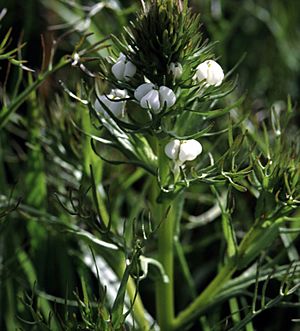Yellowbeak owl's-clover facts for kids
Quick facts for kids Yellowbeak owl's-clover |
|
|---|---|
 |
|
| Scientific classification | |
| Genus: |
Triphysaria
|
| Species: |
versicolor
|
The Triphysaria versicolor, also known as the yellowbeak owl's-clover, is a beautiful flowering plant. It belongs to the Orobanchaceae family, which includes many interesting plants.
This plant naturally grows along the west coast of North America. You can find it from British Columbia in Canada all the way down to central California in the United States. It loves to grow in open, grassy areas called grasslands.
About the Yellowbeak Owl's-Clover
What it Looks Like
The yellowbeak owl's-clover is an annual herb. This means it grows from a seed, flowers, produces new seeds, and then dies all within one year. Its stem can be green or yellowish and can grow up to about 60 centimeters (about 2 feet) tall.
Its leaves can be up to 8 centimeters long. They are divided into several narrow, pointed parts, making them look a bit spiky.
The flowers grow in a tight cluster at the top of the stem, like a dense spike. Each flower has white petals, called a corolla, which are about 1 or 2 centimeters long. The top part of the flower looks like a beak and is often tinged with yellow. The lower part is wider and has three small pouches. Sometimes, you might even see purple spots underneath the lower lip of the flower!
A Plant That Borrows Food
Like some other plants in its family, the yellowbeak owl's-clover is a special kind of plant called a facultative root parasite. This means it can sometimes get extra nutrients from other plants. It does this by attaching tiny, special roots called haustoria to the roots of nearby plants. It's like having a straw to sip some extra food and water from its neighbors!

